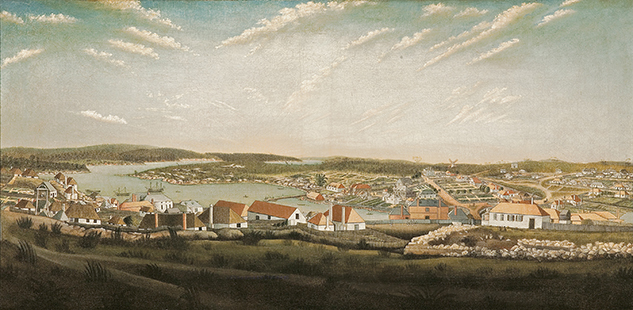 Exploring Australia’s complex colonial history and the art that emerged during and in response to this period, the National Gallery of Victoria will present concurrently from 15 March, two ambitious and large-scale exhibitions, Colony: Australia 1770 – 1861 and Colony: Frontier Wars – offer differing perspectives on the colonisation of Australia.
Exploring Australia’s complex colonial history and the art that emerged during and in response to this period, the National Gallery of Victoria will present concurrently from 15 March, two ambitious and large-scale exhibitions, Colony: Australia 1770 – 1861 and Colony: Frontier Wars – offer differing perspectives on the colonisation of Australia.
Featuring an unprecedented assemblage of loans from major public institutions around Australia, Colony: Australia 1770 – 1861 is the most comprehensive survey of Australian colonial art to date. The exhibition explores the rich diversity of art, craft and design produced between 1770, the arrival of Lieutenant James Cook and the Endeavour, and 1861, the year the NGV was established.
The counterpoint to Colony: Australia 1770 – 1861, Colony: Frontier Wars presents a powerful response to colonisation through a range of historical and contemporary works by Indigenous and non-Indigenous artists dating from pre-contact times to present day.
From nineteenth-century drawings by esteemed Wurundjeri artist and leader, William Barak, to the iridescent LED light boxes of Jonathan Jones, this exhibition reveals how Aboriginal people have responded to the arrival of Europeans with art that is diverse, powerful and compelling.
“Cook’s landing marks the beginning of a history that still has repercussions today,” says Tony Ellwood, Director NGV. “This two-part exhibition presents different perspectives of a shared history with unprecedented depth and scope, featuring a breadth of works never-before-seen in Victoria.”
“In order to realise this ambitious project, we have drawn upon the expertise and scholarship of many individuals from both within and outside the NGV. We are extremely grateful to the Aboriginal Elders and advisory groups who have offered their guidance, expertise and support.”
Charting key moments of history, life and culture in the colonies, Colony: Australia 1770–1861 includes over 600 diverse and significant works, including examples of historical Aboriginal cultural objects, early watercolours, illustrated books, drawings, prints, paintings, sculpture and photographs, to a selection of furniture, fashion, textiles, decorative arts, and even taxidermy specimens.
“I am overwhelmed at the magnitude and integrity of this display: such work and vision is a credit to the curatorial team,” said Joy Murphy-Wandin, Senior Wurundjeri Elder. “The NGV is to be congratulated for providing a visual truth that will enable the public to see, and hopefully understand, First Peoples’ heartache, pain and anger. Colony: Australia 1770–1861 / Frontier Wars is a must see for all if we are to realise and action true reconciliation.”
Highlights from the exhibition include a wondrous ‘cabinet of curiosities’ showcasing the earliest European images of Australian flowers and animals, including the first Western image of a kangaroo and illustrations by the talented young watercolourist Sarah Stone.
Examples of early colonial cabinet making also feature, including the convict made and decorated Dixson chest containing shells and natural history specimens, as well as a rarely seen panorama of Melbourne in 1841 will also be on display. Following the development of Western art and culture, the exhibition includes early drawings and paintings by convict artists such as convicted forgers Thomas Watling and Joseph Lycett.
The exhibition also includes first oil painting produced in the colonies by professional artist John Lewin; work by the earliest professional female artists, Mary Morton Allport, Martha Berkeley and Theresa Walker; landscapes by John Glover and Eugene von Guérard; photographs by the first professional photographer in Australia, George Goodman, and a set of Douglas Kilburn’s silver-plated daguerreotypes, which are the earliest extant photographs of Indigenous peoples.
Colony: Frontier Wars attests to the resilience of culture and Community, and addresses difficult aspects of Australia’s shared history, including dispossession and the stolen generation, through the works of Julie Gough, Brook Andrew, Maree Clarke, Ricky Maynard, Marlene Gilson, Julie Dowling, S. T. Gill, J. W. Lindt, Gordon Bennett, Arthur Boyd, Tommy McRae, Christian Thompson, and many more.
Giving presence to the countless makers whose identities have been lost as a consequence of colonialism, Colony: Frontier Wars also includes a collection of anonymous photographic portraits and historical cultural objects, including shields, clubs, spear throwers and spears, by makers whose names, language groups and Countries were not recorded at the time of collection. Challenging global museum conventions, the exhibition will credit the subjects and makers of these cultural objects as ‘once known’ rather than ‘unknown’.
Colony: Australia 1770 – 1861
NGV Australia at Federation Square, Melbourne
Exhibition: 15 March – 15 July 2018
Entry fees apply
Colony: Frontier Wars
NGV Australia at Federation Square, Melbourne
Exhibition: 15 March – 2 September 2018
Entry fees apply
For more information, visit: ngv.melbourne for details.
Image: Unknown Thomas Watling (after), View of the town of Sydney in the colony of New South Wales c. 1799. oil on canvas 65.0 x 133.0 cm Art Gallery of South Australia, Adelaide. Gift of M.J.M. Carter AO through the Art Gallery of South Australia Foundation in recognition of the abilities of James Bennett to promote public awareness and appreciation of Asian art and culture 2015. Donated through the Australian Government’s Cultural Gifts Program.
